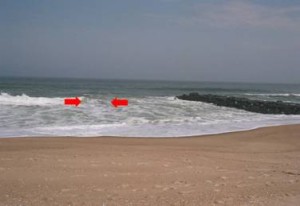Rip Current Awareness Week Aims to Educate Ocean Safety This Summer
SANDY HOOK, NJ: June 1-7 is Rip Current Awareness Week, a nationally recognized ocean safety campaign aimed at educating the public on rip currents. Organized by the National Oceanic and Atmospheric Association, the National Sea Grant Program, the United States Lifesaving Association, and the National Park Service, each year NOAA designates the first full week of June as National Rip Current Awareness Week, coinciding with the traditional start of the summer vacation season.
Rip currents are strong narrow currents moving away from shore. They form as waves travel from deep to shallow water. They are most likely to be dangerous during high surf conditions as the wave height and wave period increase. Rip currents can occur at any beach with breaking waves, including the Great Lakes.
The strongest rip currents can attain speeds reaching 8 feet per second. On average, more people die every year from rip currents than from shark attacks or lightning. According to the United States Lifesaving Association, 80 percent of surf beach rescues are attributed to rip currents, and more than 100 people die annually from drowning in rip currents.
The greatest safety precaution that can be taken is to recognize the danger of rip currents and always remember to swim at beaches with lifeguards.
The New Jersey Sea Grant Consortium (NJSGC) manages a comprehensive rip current awareness campaign for New Jersey which includes producing and distributing thousands of metal signs in English and in Spanish, warning swimmers about the danger of rip currents and illustrating what to do if caught in one. The following tips are offered by the NJSGC to help beachgoers identify and avoid dangerous rip currents:
How to Identify Rip Currents
Look for any of these clues:
- a channel of churning, choppy water
- an area having a notable difference in water color
- a line of foam, seaweed, or debris moving steadily seaward
- a break in the incoming wave pattern
How to Survive and Avoid Rip Currents
- If caught in a rip current, remain calm to conserve energy and think clearly.
- Don’t fight the current. Swim out of the current in a direction following the shoreline. When out of the current, swim towards shore.
- If you are unable to swim out of the rip current, float or calmly tread water. When out of the current, swim towards shore.
- If you are still unable to reach shore, draw attention to yourself: face the shore, wave your arms, and yell for help.
- If you see someone in trouble, get help from a lifeguard. If a lifeguard is not available, have someone call 9-1-1 . Throw the rip current victim something that floats and yell instructions on how to escape.
For more information and available safety resources follow us on Facebook and Twitter, visit https://njseagrant.org/extension/coastal-concerns/rip-current-awareness/ and http://www.ripcurrents.noaa.gov/week.shtml.
